This list has information that is from the perspective of every-day homeowners, casual hikers, and regular residents of Arizona. For example, the Arizona Ridgenosed Rattlesnake is very common in the right places, but the sight of one in the wild by a hiker or homeowner is quite rare. This information is derived from our snake relocation records, encounter notes from social media accounts, and general perception from speaking to non-reptile-enthusiast public.
If you're unsure, we will identify it for you for free., Send us a photo.
Western Diamondback Rattlesnake
Crotalus atrox
- Dangerously Venomous
- Very Commonly encountered
- Avoid or relocate if found at a home
- Snake fencing very effective
The Western Diamondback Rattlesnake is the most commonly encountered snake in the Phoenix area, and can be found anywhere where neighborhoods get close to native desert habitat. These are also sometimes called “coon-tail” rattlesnakes. They can be identified by the rattle, white and black striped tail, and white-lined diamond pattern on the back. Coloration is usually drab shades of brown or grey. They are often mistaken for the Mojave Rattlesnake. A large adult diamondback in our area would be in the 3.5’ to 4’ range, with most being smaller. They are generally quick to be defensive, and quite venomous, so keep your distance and leave it alone if encountered.


Southwestern Speckled Rattlesnake
Crotalus pyrrhus
- Dangerously Venomous
- Commonly encountered
- Avoid or relocate if found at a home
- Snake fencing very effective
The Southwestern Speckled Rattlesnake lives in rocky areas near mountains or hillsides. They’re common in the Camelback Mountain region, South Mountain area, and other parts of the valley adjacent to similar habitat. The Speckled Rattlesnakes is highly variable in color, from a white/grey in the South Mountain and White Tanks areas, brown in North Phoenix, and orange and red going North into Cave Creek and the Anthem areas. They have a loosely banded pattern that is highly flecked to resemble granite within their habitat, and are usually small, with adults being typically around 2’ in length. They have a highly toxic bite and should always be left alone when seen.


Northern Blacktailed Rattlesnake
Crotalus molossus molossus
- Dangerously Venomous
- Commonly encountered
- Avoid or relocate if found at a home
- Snake fencing very effective
The Blacktailed Rattlesnake lives in mountainous areas and surrounding foothills, and are more rarely found in flat desert areas in between. They are often mistaken for Mojave Rattlesnakes by vacationers, being a common sight near Sedona and other popular tourist areas. The Blacktailed Rattlesnake found near Phoenix is mostly brown, tinted with yellow, orange, or green. Unlike other large-bodied rattlesnakes in the area, they have a solid black tail area just before the rattle, as opposed to rings or stripes. They are usually calm, but will stand their ground when threatened. They should always be left alone if encountered.
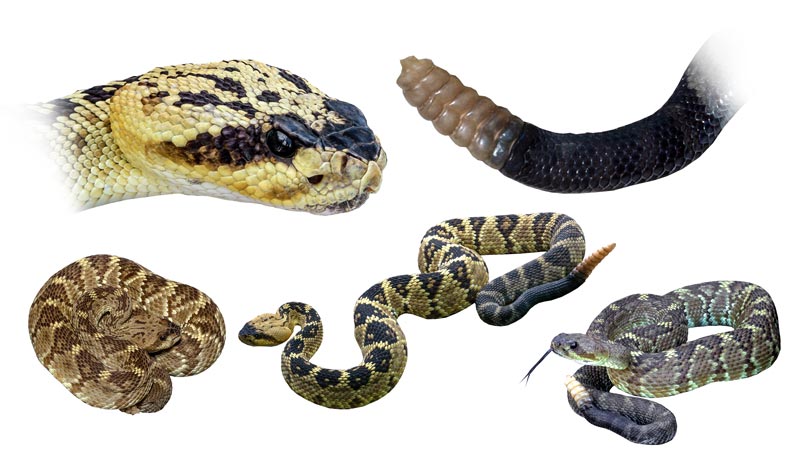

Tiger Rattlesnake
Crotalus tigris
- Dangerously Venomous
- Rarely encountered
- Avoid or relocate if found at a home
- Snake fencing very effective
The Tiger Rattlesnake lives in many of the same rocky, mountainous areas as the Speckled Rattlesnake. They are seldom seen, but live in most of the Phoenix mountain areas and desert parks. The Tiger Rattlesnake is often confused with the Speckled Rattlesnake, but can be easily identified by the unusually small head and overly large rattle. The banding is more apparent throughout the body, which is usually grey with varying degrees of pink, orange, or brown. This is a small rattlesnake, reaching a size of about 2.5 feet. The Tiger Rattlesnake has an unusually potent venom and should always be left alone if encountered.


Sidewinder
Crotalus cerastes ssp.
- Dangerously Venomous
- Rarely encountered
- Avoid or relocate if found at a home
- Snake fencing very effective
Sidewinders have a famous name and are extremely common where they are found, yet are quite uncommon to see for most. They live in flat, sandy scrubland desert, and avoid rocky areas and hills. They're very small snakes, reaching an adult size of only around 2 feet. They can be most easily identified by their distinct sideways motion (sidewinding), where the snake throws a loop of its body forward and pulls the rest along rather quickly. They also have two very visible 'horns' above the eyes, which helps the sidewinder live in sandy environments. Although they are small, this snake can give a very bad bite and should never be bothered. Three subspecies are found in Arizona.
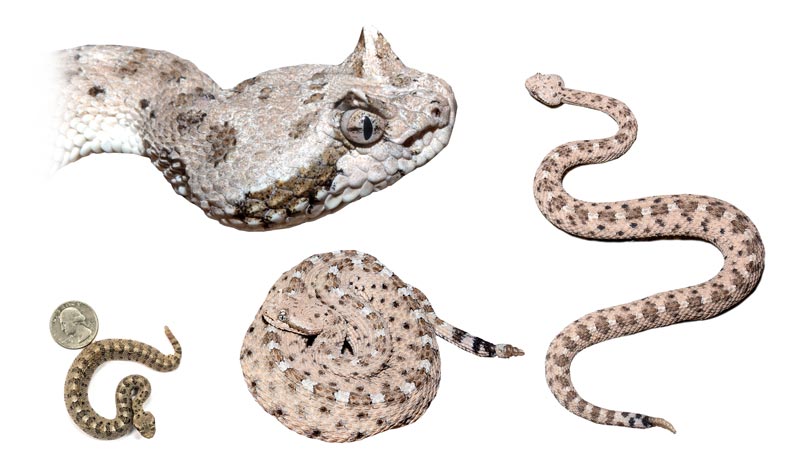
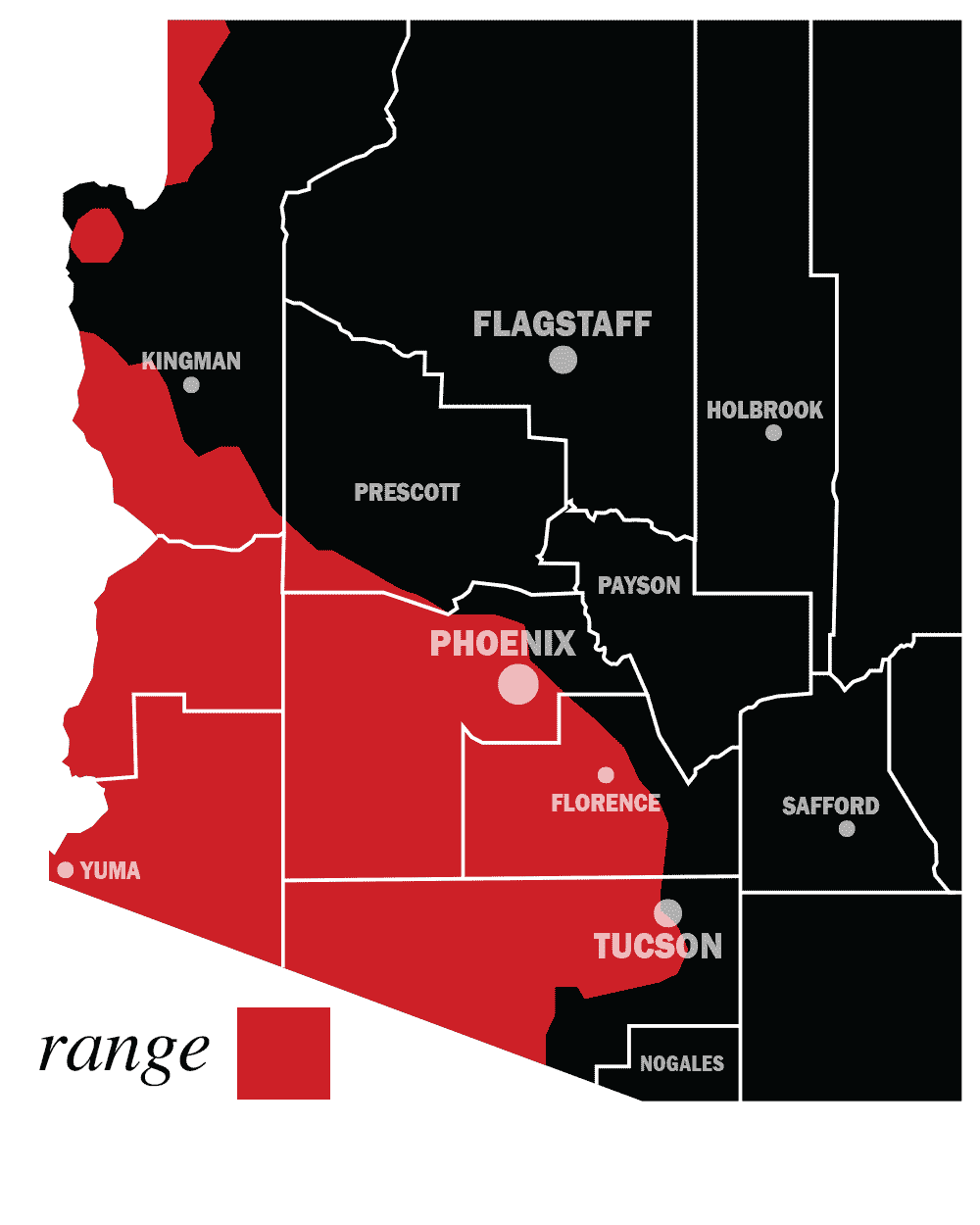
Subspecies in AZ
Sonoran Sidewinder
Crotalus cerastes cercobombus
Colorado Desert Sidewinder
Crotalus cerastes laterorepens
Mohave Desert Sidewinder
Crotalus cerastes cerastes
Mojave Rattlesnake
Crotalus scutulatus
- Dangerously Venomous
- Commonly encountered
- Avoid or relocate if found at a home
- Snake fencing very effective
The Mojave Rattlesnake , or "mojave green" as people like to say, is often confused for the similar-looking Western Diamondback, and visa versa. The Mojave is very commonly seen in flat, sandy desertscrub areas, and less likely seen in mountainous or rocky regions. It's a large snake, reaching about 4' in length as an adult. It can be distinquished from the western diamondback by the striping on the tail. Stripes are generally 2:1 white to black, while the diamondback are 50:50 white to black. The Mojave also has a generally more 'clean' appearance, with more distinct diamonds and less black speckling throughout the body. This snake has a reputation of being an overly dangerous snake, as it is quick to become defensive and has a powerful neurotoxin in many parts of its range. These snakes should always be avoided if seen.


Arizona Black Rattlesnake
Crotalus cerberus
- Dangerously Venomous
- Commonly encountered
- Avoid or relocate if found at a home
- Snake fencing very effective
The Arizona Black Rattlesnake is sometimes mistakenly referred to as “Timber Rattlesnake” throughout it’s range due to generally being found at higher altitudes in wooded areas. They are commonly seen in mountains North of Phoenix. This is a thick-bodied, large rattlesnake. Coloration is light as a young snake, being tan or grey with brown circles down the back. A the snake matures, it will darken to a deep brown color to completely black. They can also change color to some degree, becoming more light or dark depending on various circumstances. This snake can deliver a large amount of highly toxic venom and should be left alone if encountered.


Twin-Spotted Rattlesnake
Crotalus pricei
- Dangerously Venomous
- Very Rarely encountered
- Protected - do not interact
- Snake fencing not necessary
The Twin Spotted Rattlesnake is a very small, grey, blue-grey, or tan rattlesnake from the highest elevations of South East Arizona. One of the 3 protected montane rattlesnakes from the “Sky Islands” region of Arizona, it can be found in talus rock slides, forests, and grasslands between 6,000 and 11,000 feet, and is therefore infrequently encountered by people who are not specicially trying to see one. The tiny rattle creates an insect-like sound that can only be heard in close proximity. Due to superficial similarities in appearance, the unrelated Desert Nightsnake is often misidentified as a Twin Spotted Rattlesnake by concerned home owners searching online.


Banded Rock Rattlesnake
Crotalus lepidus klauberi
- Dangerously Venomous
- Commonly encountered
- Protected - do not interact
- Snake fencing not necessary
The Banded Rock Rattlesnake is a small, specialized species of rattlesnake that lives in the mountainous “sky islands” region of extreme Southeastern Arizona. As its name implies, it is found in association with rocky areas, canyons, and woodland with sun-exposed outcroppings. The banded rock rattlesnake usually has a grey base coloration, and a series of black bands, sometimes with a very bright teal or green outline. Males can be be green, often nearly metallic in appearance, with varying amounts of pink or blue-grey. Protected throughout its limited range in Arizona, this snake should be avoided.

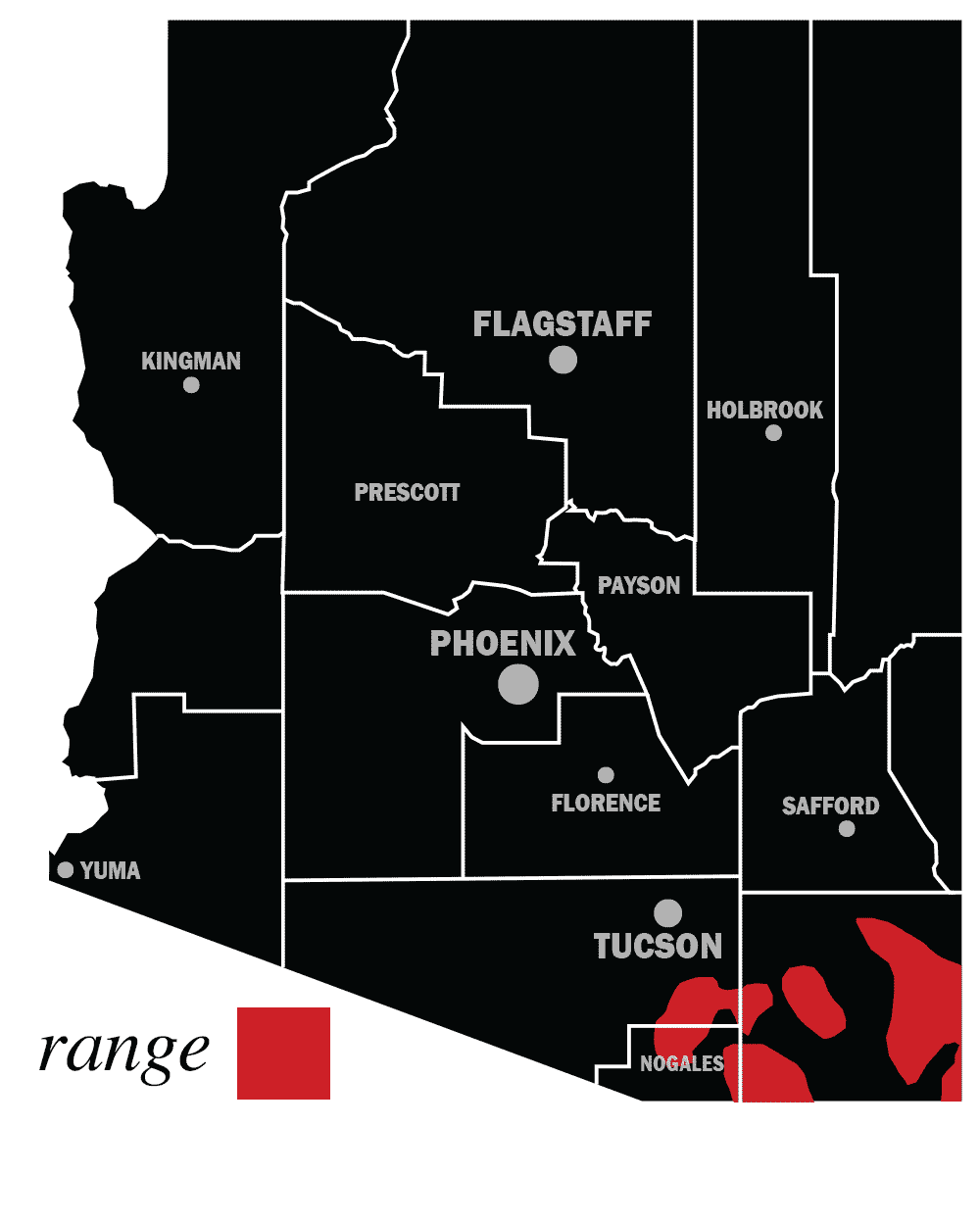
Arizona Ridgenosed Rattlesnake
Crotalus willardi willardi
- Dangerously Venomous
- Rarely encountered
- Protected - do not interact
- Snake fencing not necessary
The Arizona Ridgenosed Rattlesnake is the Arizona state reptile. It is one of three protected rattlesnake species in the state, due to limited range and collection by poachers. It is a relatively small snake, with adults seldom exceeding 2’ in length. In the U.S., it is found in only a handful of mountain ranges in the “sky islands” region of Southeast Arizona at elevations above 4,000’. It lives in Madrean Woodlands and adjacent grassy hillsides. This individual is one of a pair collected under permit from AZGFD to represent the species in educational presentations, and provide legal, captive-born specimens to Arizona educational programs.


Subspecies in AZ
New Mexico Ridgenosed Rattlesnake
Crotalus willardi obscurus
New Mexico Ridgenosed Rattlesnake
Crotalus willardi obscurus
- Dangerously Venomous
- Rarely encountered
- Protected - do not interact
- Snake fencing not necessary
The New Mexico Ridgenosed Rattlesnake is a small, grey, or light tan rattlesnake found in only a sliver of remaining suitable habitat in Arizona along the Arizona and New Mexico border. Though it is found in two other mountain ranges, the long-term survival of this subspecies in Arizona is unlikely. Habitat loss, driven by climate change and fire, has made this perhaps the rarest snake in the state. For that reason and others, it is a federally-protected endangered species.


Subspecies in AZ
Arizona Ridgenosed Rattlesnake
Crotalus willardi willardi
Desert Massasauga
Sistrurus tergeminus
- Dangerously Venomous
- Rarely encountered
- Protected - do not interact
- Snake fencing not necessary
The Desert Massasauga is the lone representative of the Sistrurus genus in Arizona, making it the most distantly related of all rattlesnake species in the state. It is small, usually tan, grey, or brown, and may superficially resemble a Prairie Rattlesnake to an untrained eye. In Arizona, the remaining tobosa grass habitat of the Massasauga is in decline due to development and grazing of cattle. While isolated populations continue to exist, numbers are in decline and eventual extirpation is likely. The Desert Massasauga is protected in Arizona from all forms of collection and harrassment, though habitat-conservation is likely the only means of saving this species in our state.


Great Basin Rattlesnake
Crotalus oreganus lutosus
- Dangerously Venomous
- Very Commonly encountered
- Avoid or relocate if found at a home
- Snake fencing very effective
The Great Basin Rattlesnake is one of the widest-ranging rattlesnakes in the Western US, being found in AZ, CA, NV, OR, ID, and UT. In AZ, this snake is only found in the extreme North Western Great Basin desert and Arizona Strip regions, up to 8,000 feet in elevation. The “smudge” on the head is an easy differentiator between this snake and the other species of Western Rattlesnake (Grand Canyon and Midget Faded rattlesnakes). Extremely variable in color and pattern, they can be found in brilliant yellow, nearly black-and-white, brown, grey, and appear nearly patternless to high-contrast black and gold - all within the same community. This snake can top out at lengths of 5’ in rare instances, but most adults end up in the 3’-3.5’ range.


Grand Canyon Rattlesnake
Crotalus oreganus abyssus
- Dangerously Venomous
- Rarely encountered
- Avoid or relocate if found at a home
- Snake fencing very effective
The Grand Canyon Rattlesnake is a medium-sized rattlesnake that can only be found within the Grand Canyon, Paria River Drainages, and Glen Canyon areas of Northern Arizona. The grand canyon rattlesnake is tan, yellowish, or pink in color; a good match for the colorful rocky areas that make up the majority of its range. This snake has a pattern of irregular blotches along the back, often with a dark brown outline. When born, the pattern is highly contrasted but fades as the snake grows. Mature adults can appear to be all but patternless.


Midget Faded Rattlesnake
Crotalus oreganus concolor
- Dangerously Venomous
- Very rarely encountered
- Avoid or relocate if found at a home
- Snake fencing very effective
The Midget Faded Rattlesnake is a small and elusive rattlesnake just barely makes it across the northern Arizona border. Restricted to a handful of canyons and drainages, most of its habitat lies beneath Lake Powell. They are the smallest species of the former Western Rattlesnake complex, reaching an adult size of under 2 feet. As adults, they are usually tan, yellow, orange, or brown in color, with a minimized pattern that can fade into a nearly patternless appearance, as the name suggests. The Midget Faded Rattlesnake is also notable for its particularly potent neurotoxic venom, referred to as “concolor toxin”.


Prairie Rattlesnake
Crotalus viridis
- Dangerously Venomous
- Very commonly encountered
- Avoid or relocate if found at a home
- Snake fencing very effective
The Prairie Rattlesnake , (or Hopi Rattlesnake, depending on the area) is a wide-spread and extremely variable species, found in the North Eastern portions of Arizona, East of the Colorado River. Color, size, and pattern can vary greatly between communities, from small orange or reddish variants, or “Hopi” variety, to large-bodied, green, tan, or brown individuals. In Arizona, they are mostly found at higher elevations, between 4’500’ and 9,000’, inhabiting nearly every habitat type within their range. The Prairie Rattlesnake can be identified by the characteristically narrow light-colored facial stripes, and dorsal blotches that are often outlined oval or bow-tie shapes. They are often misidentifed as “Mojave Green” rattlesnakes in New Mexico and Northern Arizona.


Sonoran Coralsnake
Micruroides euryxanthus
- Dangerously Venomous
- Rarely encountered
- Avoid or relocate if found at a home
- Snake fencing not effective
The Sonoran Coralsnake , a venomous species, is infrequently spotted in the southern regions of Arizona. Typically measuring less than 2 feet in length and as slender as a pencil in adulthood, its body showcases striking bands of black and red, interspersed with white or faint yellow stripes. Notably, its face is cloaked in black, and its tail lacks the final red band. Contrary to common belief, the well-known rhyme "red-touch-yellow" is an unreliable method for identifying this snake. This leads many to mistakenly classify benign species like the Longnosed Snakes, Groundsnakes, and Shovel-Nosed Snakes as the Sonoran Coralsnake due to their superficial resemblance. Distinct from the Eastern coralsnake genus, the Sonoran variety isn't perceived as threatening unless deliberately provoked. Possessing static front fangs and potent neurotoxic venom, there haven't been any reported fatalities from its bite. Interestingly, an encounter with this snake in a household might hint at a lurking termite problem.


Gila Monster
Heloderma suspectum
- Dangerously Venomous
- Rarely encountered
- Avoid or relocate if found at a home
- Snake fencing not effective
The Gila Monster is one of the most iconic animals of the Sonoran desert. It lives across Arizona’s desert and grassland regions below the Mogollon rim, and is common throughout its range, despite being rarely seen on the surface. The gila monster is often confused with other large, desert lizards, such as the chuckwalla and desert iguana, but can be easily distinguished by it’s high-contrast black and yellow pattern. Although highly venomous, they should not be considered dangerous. Slow-moving and non-aggressive, bites are easily avoided simply by not approaching or attacking one when encountered. They are protected by state law and should always be left alone.
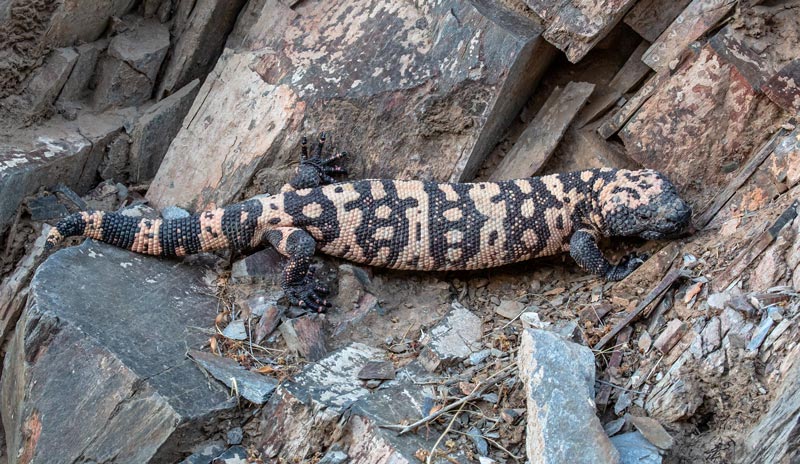
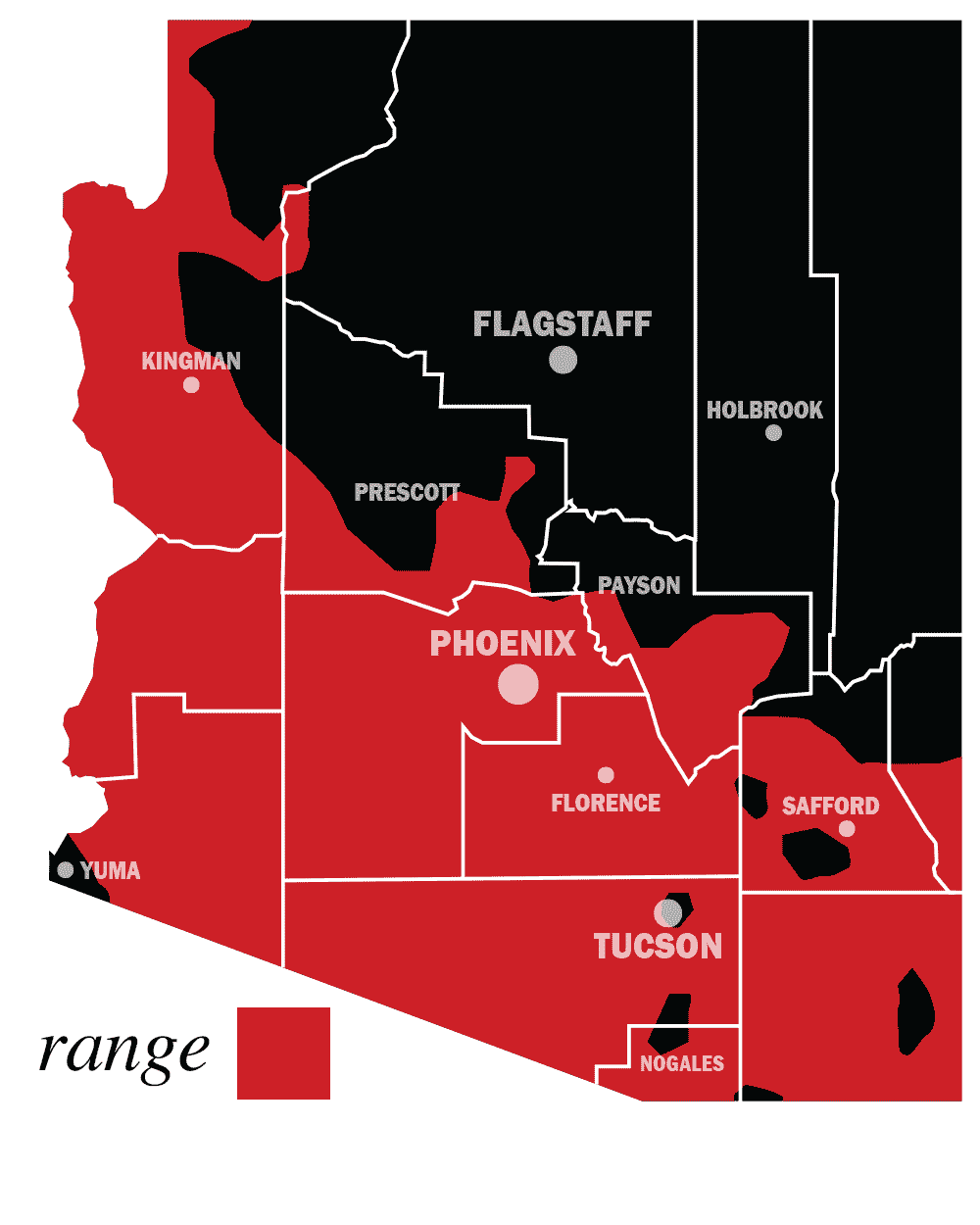
Gophersnake
Pituophis catenifer
- Harmless
- Very commonly encountered
- No action necessary
- Snake fencing somewhat effective
Next to the Western Diamondback, the Gophersnake may be the most commonly snake seen in Arizona. This is not only due to it being incredibly common, but also because it has adapted very well to life in the city. They can be found on golfcourses, parks, alleyways, and back yards throughout the city. They can be very large, with adults commonly exceeding 5' or more in length. They are often mistaken for rattlesnakes because of their superficial likeness, and tendency to quickly become defensive when approached. They will open their mouths to hiss, and even rattle their striped tail while striking out towards a perceived threat. While they are not at all venomous, they may bite if handled, the worst result being a few cuts on the hand. They are great pest control (which can actually help keep other, venomous species away), and are great to have around for that reason.


Subspecies in AZ
Sonoran Gophersnake
Pituophis catenifer affinis
Great Basin Gophersnake
Pituophis catenifer deserticola
Glossysnake
Arizona elegans
- Harmless
- Rarely encountered
- No action necessary
- Snake fencing very effective
Glossysnakes are medium-sized (up to about 3' long) snakes that are often confused with the similar-looking Sonoran Gophersnake. As the name suggests, the Glossy Snake's appearance is often shiny or, well, glossy, due to a lack of ridge (keel) on each scale as is found in the Gophersnakes. Usually brown and tan, oranges and pink colors can be found as well, especially in the Painted Desert (Arizona elegans philipi) subspecies. They are harmless, but may attempt to bite and rattle their tail defensively. While they are common in the sandy soil and grasslands where they live, they are relatively elusive. Of species found within the metro-areas of Phoenix and Tucson, they are very infrequently encountered, with only a handful of individuals in our relocation records.


Subspecies in AZ
Desert Glossy Snake
Arizona elegans eburnata
Arizona Glossy Snake
Arizona elegans noctivaga
Painted Desert Glossy Snake
Arizona elegans philipi
Sonoran Lyresnake
Trimorphodon lambda
- Mildly Venomous
- Rarely encountered
- No action necessary
- Snake fencing somewhat effective
The Sonoran Lyresnake is a very thin, snake found throughout the desert regions of Arizona. It is called a “lyre” snake because head markings that resemble a lyre harp. It is nocturnal, and rarely seen. The lyresnake eats primarily lizards, and also preys on small rodents, bats, and birds. Though venomous, it constricts prey while venom is delivered by a chewing action. This snake is mildly venomous and not considered dangerous, but should still not be handled when encountered. Bites may cause irritation and pain, but do not require hospitalization and have no long-lasting effect.


Sonoran Mountain Kingsnake
Lampropeltis pyromelana
- Harmless
- Rarely encountered
- No action necessary
- Snake fencing somewhat effective
The Sonoran Mountain Kingsnake is a seldom-seen, non-venomous snake found in higher elevation mountainous woodlands throughout Arizona. It can also be found in rocky canyons, riparian areas, and transitional grasslands adjacent to heavily forrested areas. The light-colored, squared nose can be used to distinguish this snake from the rounded, dark snout of the milksnake. More distantly, it is sometimes mistaken for a coralsnake. It is an eater of lizards, as well as small mammals, and birds. Unlike other kingsnakes, other snakes are not on the menu for this species. The Sonoran Mountain Kingsnake is a harmless constrictor that is not cause for alarm if seen.

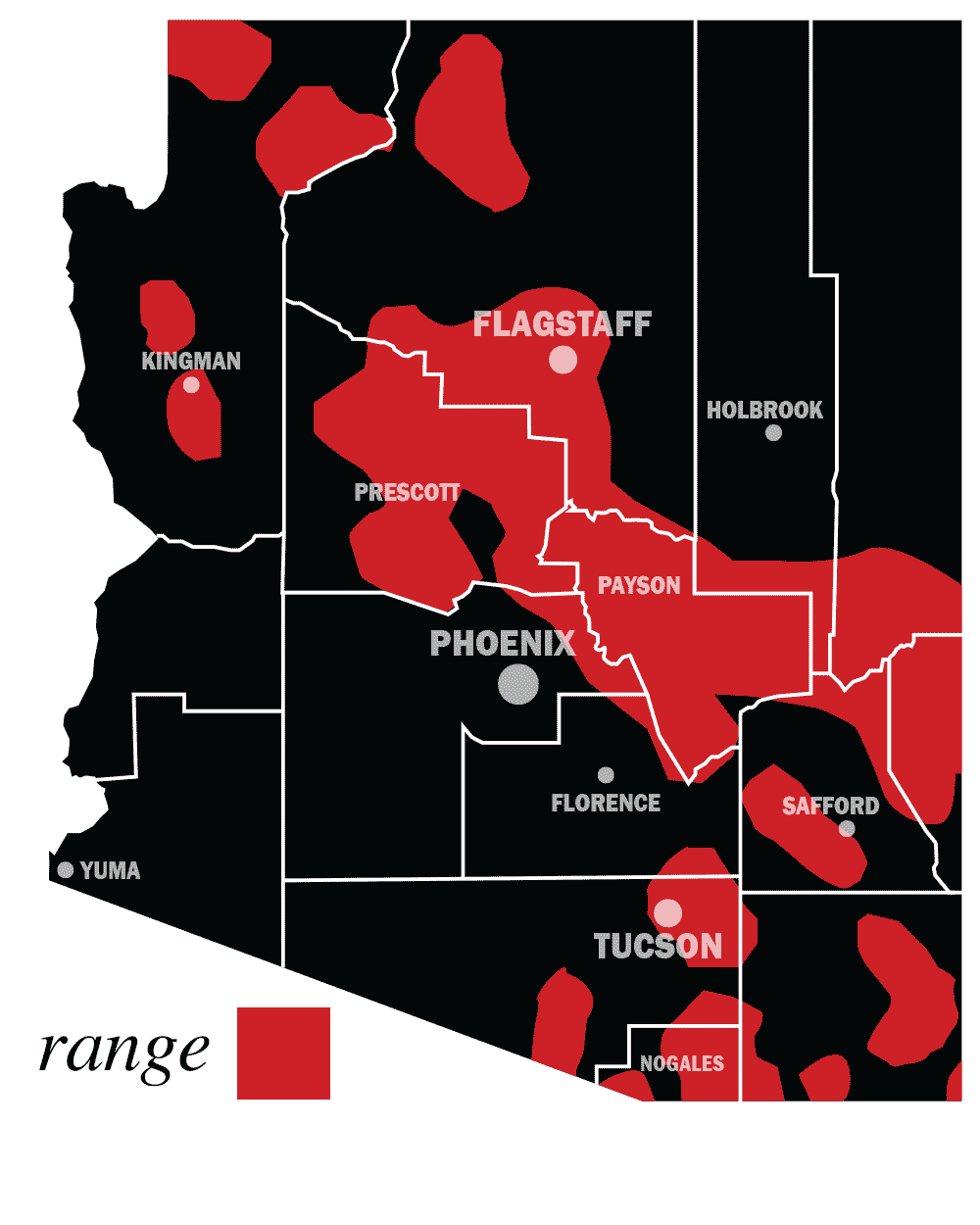
Ring-Necked Snake
Diadophis punctatus
- Mildly Venomous
- Very Rarely encountered
- No action necessary
- Snake fencing not effective
These are exceptionally beautiful snakes that often cause even snake-haters to admit that they're pretty. The brilliant orange, yellow, and red coloration on the belly becomes exposed when the snake is stressed, with the tail forming a tight coil and the latter portion of body flopped upside-down. The upper body is slate-grey or even steel blue in appearance, sometimes with a yellow or cream colored ring just behind the head. These are typically small snakes, with adults in the Phoenix and Tucson areas usually in the 12-18" range ... but elsewhere in Arizona they can reach sizes up to almost 3' long. The head is relatively small and body thin compared to length. They are primarily snake eaters, but also eat lizards and invertebrates. Their venom can quickly kill its prey, but is not something that should be considered harmful to humans or pets. They almost never bite, and if allowed to chew their mild venom into a hand (which is the only way a bite is going to happen), it may result in some temporary local swelling and redness.


California Kingsnake
Lampropeltis californiae
- Harmless
- Commonly encountered
- No action necessary
- Snake fencing somewhat effective
The California Kingsnake is usually identified by the stark white and black, or yellow and black, banding that runs the length of the body. However, they are very often confused with baby Longnosed Snakes, which have a very similar pattern. The Kingsnake’s head shape is slightly different, with a more rounded appearance. The banding is also more complete at the sides, where a Longnosed Snake’s bands may include blotches of white or grey on each side. Kingsnakes are medium-sized, harmless snakes. Adults in the Phoenix area are commonly in the 3′ range, with exceptional animals approaching 4′. They are often found as babies during August and September, having found their way into garages and homes. They are generally considered as beneficial snakes, regardless of fondness for snakes, since they regularly prey on rattlesnakes.


Desert Kingsnake
Lampropeltis splendida
- Harmless
- Commonly encountered
- No action necessary
- Snake fencing somewhat effective
The Desert Kingsnake's pattern consists of chain-link, or "plaid", speckled banding of black and cream-white. The pattern can become nearly solid black in mature snakes, to a speckled/banded pattern in areas where it intergrades with the California Kingsnake. It is a medium-sized, harmless snake. Adults are commonly in the 3′ range. They are often found as babies late in the year in garages, backyards, and golf courses. They are considered to ne beneficial snakes, as a regular predator of venomous rattlesnakes. The presence of a Desert Kingsnake on a property may help reduce the likelihood of rattlesnake encounters.
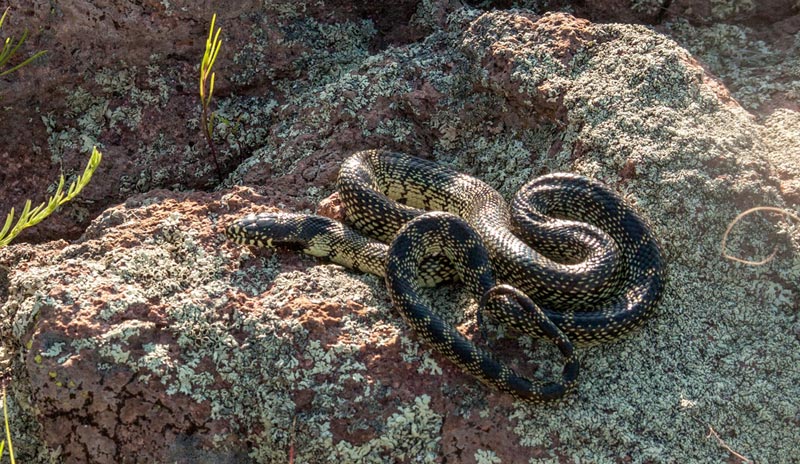

Desert Nightsnake
Hypsiglena chlorophaea
- Harmless
- Very Commonly encountered
- No action necessary
- Snake fencing not effective
Nightsnakes are the most common snake to see inside of the home, in our experience. They are great at getting into small cracks and even get through pipes, and end up on kitchen counters, in bathroom sinks, and all kinds of surprising places. They are very small, generally less than a foot long, and are often mistaken as baby rattlesnakes due to their triangular head and vertical eye slits. In fact, they are completely harmless, and it would be a challenge to try to get one to try and bite. When they are scared, they coil into a tight ball and hide their head under the body. They eat scorpions, spiders, and are great to have around the yard.


Chihuahuan Nightsnake
Hypsiglena jani
- Harmless
- Very Commonly encountered
- No action necessary
- Snake fencing not effective
This snake looks nearly identical to the more commonly-encountered Desert Nightsnake, and placement within the known range (see map) is the best way to differentiate between the two. They are small snakes, generally about a foot long (up to nearly 2' maximum length). The color is generally grey or tan, with a series of darker blotches or saddles that extend the length of the body. Behind their slightly arrow-shaped head, a black "hood" or collar is present. These snakes are often misidentified as rattlesnakes because of their head shape, vertical pupils, and tendency to coil into a tight circle when threatened.


Rosy Boa
Lichanura roseofusca
- Harmless
- Very Rarely encountered
- No action necessary
- Snake fencing not necessary
They are one of two species of Boa found in the state, the Rssy Boa are secretive snakes found in mountains of western Arizona. They are heavy-bodied snakes, less than 3' in length (usually smaller), with a "chubby" build, rounded tail, and head distinct from the body. The color is variable, usually consisting 3 dark brown, red, or orange stripes running nose-to-tail against a lighter, cream or white base color. They can be found on the surface in early Spring or late at night during the summer, and are rarely seen in general. Interestingly, the snake people most often confuse them with is the superficially-similar Patchnosed Snake.


Three-Lined Boa
Lichanura trivirgata
- Harmless
- Very Rarely encountered
- No action necessary
- Snake fencing not necessary
They are one of two species of Boa found in the state, Three-Lined Boas are secretive snakes found in a handful of mountain ranges south of the Gila River. They are heavy-bodied, less than 3' in length, with a "chubby" build, rounded tail, and head distinct from the body. Their color is variable, usually consisting 3 dark dark brown stripes running the length of the body against a cream or grey base. They can be found on the surface in early Spring and late-night during warmer times.


Western Groundsnake
Sonora semiannulata
- Harmless
- Very Commonly encountered
- No action necessary
- Snake fencing not effective
Groundsnakes are very small, with an adult size of only around 10". They can be difficult to identify by using photographs, since they are highly variable in appearance. They can be banded, striped, red, orange, grey, olive, tan, or any combination of these colors. As babies, they are very small, only around 3" long, and may resemble a Blackheaded Snake until their mature coloration develops. Groundsnakes are completely harmless, never bite, and cannot hurt a person of any age or any size of pet. They can be mistaken for the Sonoran Coralsnake on occasion, but in general are easy to differentiate by the lack of white or yellow bands. The place we have most often been called out to retrive them from is the garage, where they get stuck in glue traps or are found under boxes in the Spring.


Banded Sandsnake
Chilomeniscus cinctus
- Harmless
- Rarely encountered
- No action necessary
- Snake fencing not necessary
This small, colorful snake is sometimes seen by homeowners who live near areas with sandy soil or wash systems. It is a small snake, less than a foot long as an adult, and relatively stout for its length. The body alternates between black bands over an orange or cream-colored base, usually fading from a rich orange color on the back to lighter colors below. It's face is relatively long and shovel-shaped. It spends its time moving around sandy soil searching for invertebrates to eat, and is rarely seen in the daytime. You may be able to differentiate it from the very similar-looking Groundsnake by the relatively short, fat appearance relative to its length. They do not bite and are completely harmless, and OK to have in your yard.


Resplendent Shovel-Nosed Snake
Chionactis annulata
- Harmless
- Rarely encountered
- No action necessary
- Snake fencing not necessary
Shovel-Nosed Snakes are pretty, small snakes that live throughout the sandy areas of western Arizona. This species usually shows clean, alternating red or orange bands that do not encircle the entire body, which alternate with black bands. This is the species of Shovel-nosed Snake homeowners may find in the sandy areas around Phoenix. As adults, they are less than a foot long. They are long and slender in comparison with, as the name suggests, a flat, slightly up-turned nose that is used to move through sand. They do not bite and are completely harmless, and OK to have in your yard.


Mohave Shovel-Nosed Snake
Sonora (Chionactis) occipitalis
- Harmless
- Rarely encountered
- No action necessary
- Snake fencing not necessary
This species of Shovel-Nosed Snake are small, as are the other Shovel-nosed Snakes with white or cream and black bands and no red or orange. As adults, they are less than a foot long. This species is only found in Arizona in sandy areas of Mohave County. They look very similar to the Banded Sandsnakes, Groundsnakes and other species of Shovel-nosed Snake. They are long and slender in comparison with, as the name suggests, a flat, slightly up-turned nose that is used to move through sand. They do not bite and are completely harmless, and OK to have in your yard.


Sonoran Shovel-Nosed Snake
Sonora (Chionactis) palarostris
- Harmless
- Rarely encountered
- No action necessary
- Snake fencing not necessary
Shovel-Nosed Snakes are colorful, small snakes (less than a foot long) that live throughout the sandy areas of Arizona. The Sonoran Shovel-nosed Snake is similar in appearance to the other Shovel-nosed snakes in the state, appearing in varying amounts of white or cream, orange-red, and black bands. This snake is found in Arizona only from a small area in the Organ Pipe National Monument, and encounters are exceptionally rare.

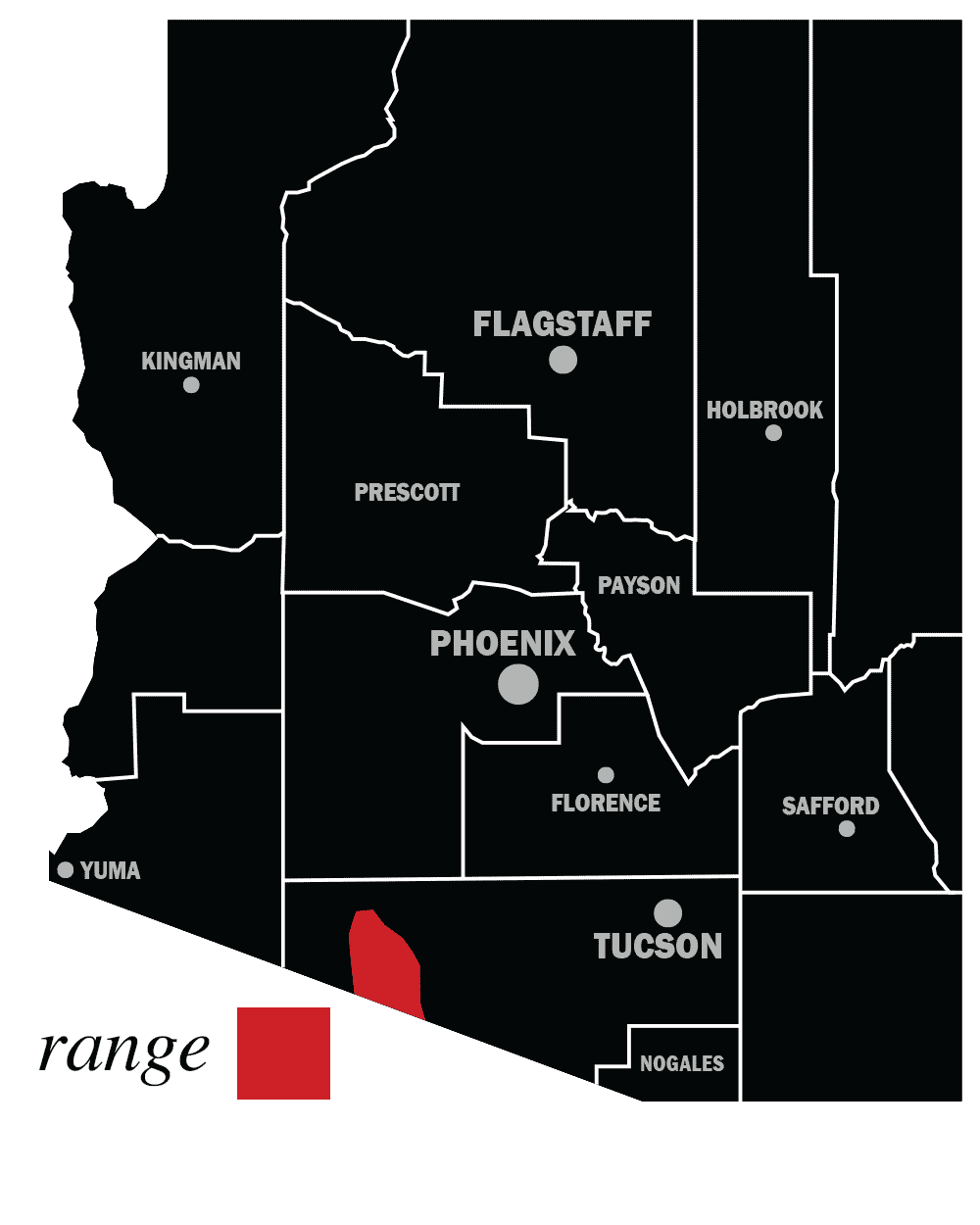
Long-Nosed Snake
Rhinocheilus lecontei
- Harmless
- Very Commonly encountered
- No action necessary
- Snake fencing somewhat effective
The Long-Nosed Snake is usually patterned with speckled black and white bands, with varying amounts of red or orange coloration. As hatchlings, they may completely lack any red coloration whatsoever, making them look very similar to Kingsnakes. They range in size between about 7″ as a hatchling, to around 3′ as adults. In addition to being often mistaken for a Kingsnake, this snake is frequently misidentified as a Sonoran Coralsnake. Longnosed Snakes are completely harmless, and almost never bite, even if provoked to an extreme level. Their primary defense is to defecate and musk when picked up, as well as occasionally bleed from the cloaca. This is meant as a deterrant to predators, who may not want a mouthful of nasty goop. During the monsoon season each year, Longnosed Snakes hatch from eggs and wander in search of food. During these first weeks of life, they often find their way into homes.


Western Patchnosed Snake
Salvadora hexalepis
- Harmless
- Commonly encountered
- No action necessary
- Snake fencing somewhat effective
The Western Patchnosed Snake is often encountered on dirt roads in the morning or late afternoon by hikers as they bask in the sun, then quickly dart off the road. They're slender, medium-sized snakes that get up to around 3' long. Their color has often been described as "straw", or tan, cream, or a peach tint, with a series of black or brown stripes that run from just behind the eye to the tail. The stripes have a slight saw-tooth look, unlike the straight stripes of the Eastern Patchnosed Snake. On the end of the nose is an enlarged scale that looks like a small, bent guitar pick, which the snake uses to hunt lizards hiding in shallow sand. They're quick, and most people only get a glimpse of them before they disappear, which often leads to misidentification as a Coachwhip or Whipsnake. They're harmless but might give a minor bite (some scratches) if picked up.


Subspecies in AZ
Desert Patchnosed Snake
Salvadora hexalepis hexalepis
Big Bend Patchnosed Snake
Salvadora hexalepis deserticola
Mojave Patchnosed Snake
Salvadora hexalepis mojavensis
Eastern Patchnosed Snake
Salvadora grahamiae
- Harmless
- Commonly encountered
- No action necessary
- Snake fencing somewhat effective
Eastern Patchnosed Snakes are often encountered at mid-morning and just before sunset by hikers, mountain bikers, and other active outdoor individuals on dirt roads and trails at at high elevation. They are medium-sized, very slender, fast snakes, usually around 2' in length as adults. On the nose is its name-sake, a shovel-shaped scale that looks like a small, bent guitar pick used to help dig prey from soft dirt. They have smooth-edged, solid dark stripes that run laterally from head to tail, unlike the jagged-edged lines of the more commonly-seen Western Patchnosed Snake. They are harmless and quick to escape, and pose no threat to people or pets.

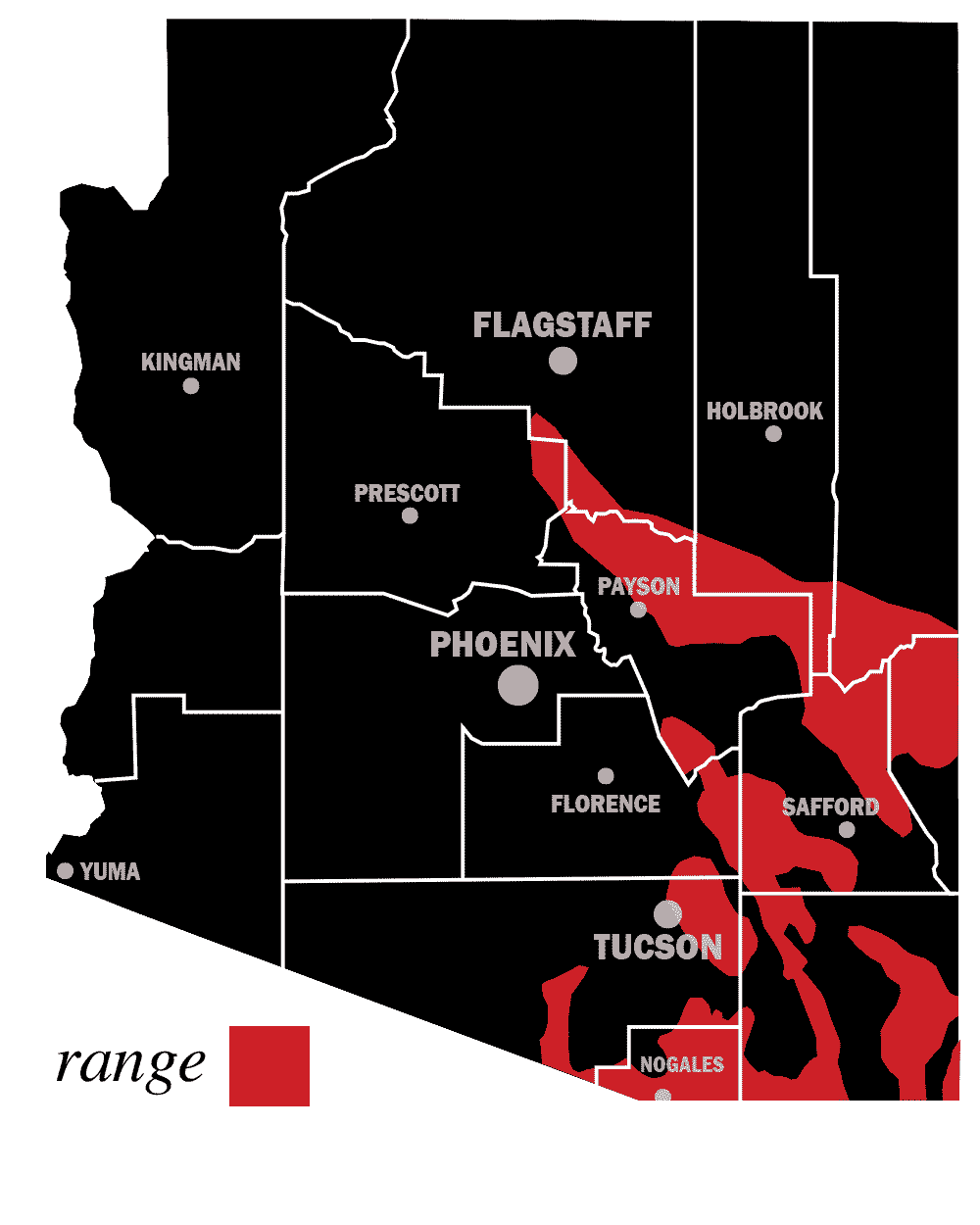
Saddled Leafnosed Snake
Phyllorhynchus browni
- Harmless
- Very Rarely encountered
- No action necessary
- Snake fencing somewhat effective
This small, harmless snake is one of the most rarely-seen species that lives along the highly-urbanized areas of Phoenix and Tucson. They're small, usually only around a foot long. They are a cream or tan color with, unlike the similar Spotted Leaf-Nosed Snake, a series of dark brown, incomplete bands along the body that are relatively few. The face has an enlarged scaled shaped like an upside-down heart that they use to push through sandy soil. They are heavy-bodied for their size, which can help differentiate them from the more commonly-seen Longnosed Snakes and variety of other small, ground-dwelling species. An eater of primarily lizard eggs, this snake is completely harmless. If stressed, it might perform a series of dramatic, fake hisses and strikes with its mouth closed, but does not actually bite.

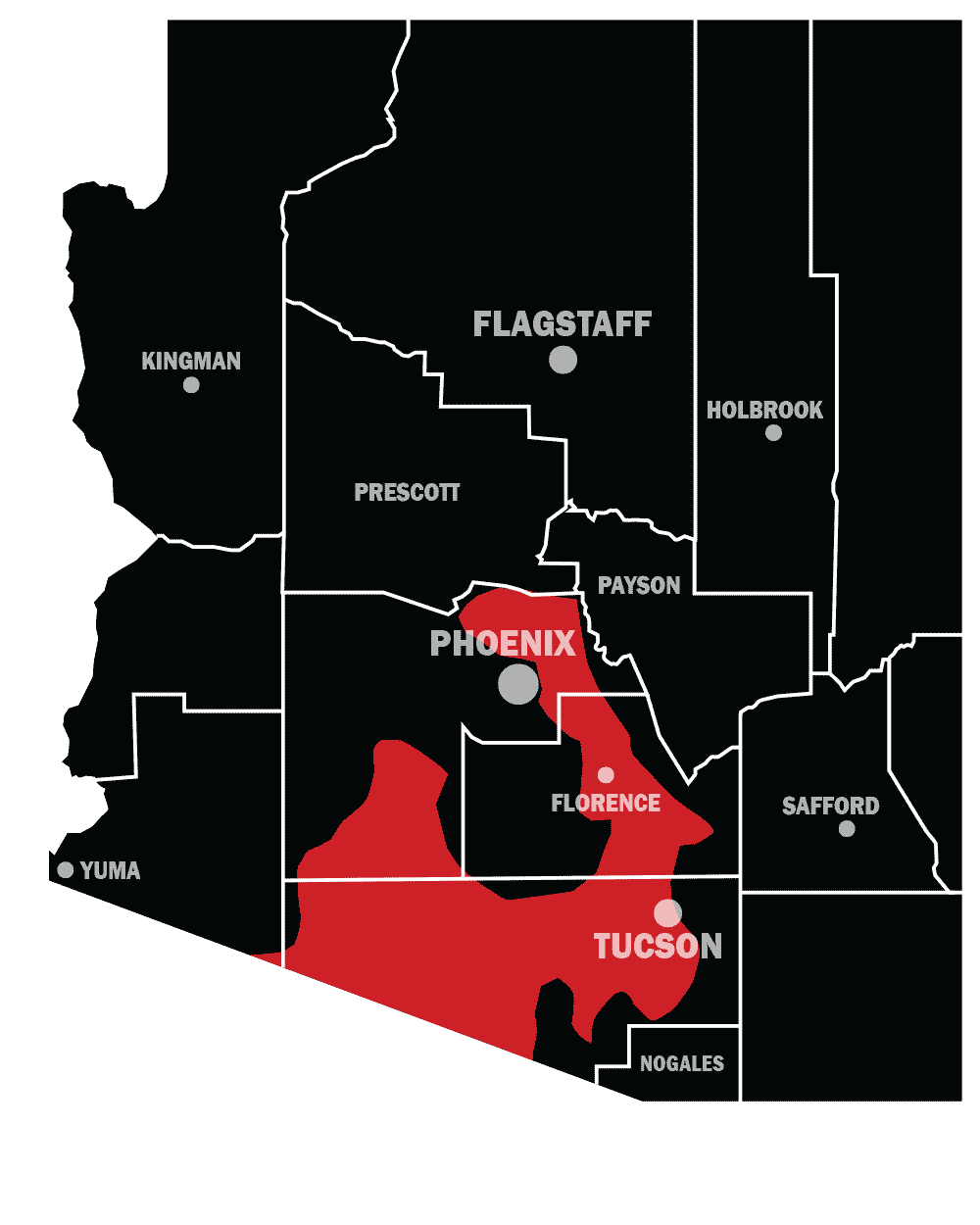
Spotted Leafnosed Snake
Phyllorhynchus decurtatus
- Harmless
- Rarely encountered
- No action necessary
- Snake fencing somewhat effective
This small, harmless snake is not often seen. They're small, usually only around a foot long. They are a cream, pink, or tan color with irregularly-shaped blotches along the back, from head to tail, in a much higher frequency than the few saddles appearing on the Saddled Leafnosed Snake. The face has an enlarged scaled shaped like an upside-down heart that they use to push through sandy soil. They are heavy-bodied for their size, which can help differentiate them from the more commonly-seen variety of other small, ground-dwelling snakes. An eater of primarily lizard eggs, this snake is completely harmless. If stressed, it might perform a series of dramatic, fake hisses and strikes with its mouth closed, but does not actually bite.


Coachwhip
Masticophis flagellum
- Harmless
- Very Commonly encountered
- No action necessary
- Snake fencing not effective
Also often called a "red racer", Coachwhips are long, thin snakes that can reach lengths of up to around 5′. They are also very fast, and are very difficult to capture for this reason. Most encounters with a Coachwhip are just a quick glance as it quickly slides away from the area. They can be a variety of colors; brown and tan is most common, though they also may be red, pink, orange, or black. They have large, round eyes that angle forward through indentations in the face, and can appear to be looking forward. They are reasonably intelligent, agile snakes, that can climb trees, climb walls, fences, and are found in about any place imaginable. Coachwhips can help reduce rattlesnakes in an area because they are rattlesnake-eaters. They also consume about any type of rodent, lizard, or bird that will fit in their mouth, also reducing rattlesnake encounters by simply being competition. Coachwhips will bite if picked up, but are not venomous.


Subspecies in AZ
Sonoran Coachwhip
Masticophis flagellum cingulum
Lined Coachwhip
Masticophis flagellum lineatulus
Red Racer
Masticophis flagellum piceus
Sonoran Whipsnake
Masticophis bilineatus
- Harmless
- Commonly encountered
- No action necessary
- Snake fencing not effective
These fast snakes are commonly seen people enjoying the outdoors, but very rarely seen in and around homes and backyards. They're long (up to 5' – 6' long as adults) and slender and usually disappear quickly into bushes when disturbed. The color is often a slate-grey, but sometimes appears as a colorful gradient of olive green, blue, to reddish brown, with a white belly and a stripe on each side from just behind the head down the body. Their head has a more angular appearance than the similar-looking Coachwhip, with a white jaw and stripe extending through the base of the eye. They are day-active, agile predators that often eat birds, lizards, and rodents. They're harmless and non-venomous, though if someone were to pick one up it is likely to bite.


Striped Whipsnake
Masticophis taeniatus
- Harmless
- Commonly encountered
- No action necessary
- Snake fencing not effective
The Striped Whipsnake is a large-eyed, slender, fast-moving snake that is commonly seen throughout its range in Arizona. Similar in appearance to the Sonoran Whipsnake, this snake's white or cream-colored stripes are wider and more apparent, with a lateral "zipper" look going down the body. The base color can be brown, grey, or olive, and most visible as a dorsal stripe nearly as wide as the snake's head. The belly is white or cream, sometimes pink. They can reach sizes up to 5' long, though most are smaller. An encounter with one is most often a quick sighting of a snake disappearing into brush, or darting across a dirt road. They are quick to flee, but will almost certainly bite if handled.


Racer
Coluber constrictor
- Harmless
- Rarely encountered
- No action necessary
- Snake fencing not necessary
This snake is known in Arizona by only a few records near the town of Eager, Arizona. They are olive green or brown in color with a white belly. The body is typically unicolor in appearance, with large, smooth scales which may appear glossy in sunlight. They are very fast, typically darting away as soon as they are found.


Checkered Gartersnake
Thamnophis marcianus
- Mildly Venomous
- Commonly encountered
- No action necessary
- Snake fencing somewhat effective
These relatively common snakes are often found near irrigation and agricultural areas around Phoenix and Tucson, and along grassy waterways throughout much of the southeastern part of the state. They can be large, up to around 3 feet long, but most are smaller. Their color is a brown or grey base color with numerous black or darker-brown blotches that appear in a checkerboard pattern and a white belly. There is a single white or cream-colored stripe along the back, and a thin stripe along each side that runs the length of the body. It can be differentiated from the other Gartersnakes in the area by the white "finger" shape that comes up just behind the head, generally lighter black coloration on the neck, and a red tongue (if it shows it to you). Their range may be exapanding in the state due to irrigation and agricultural activity. They will eat anything they can catch, and often spend the day searching for frogs and toads and rodents along waterways.


Blacknecked Gartersnake
Thamnophis cyrtopsis
- Harmless
- Commonly encountered
- No action necessary
- Snake fencing somewhat effective
These pretty gartersnakes can be seen hunting tadpoles and small fish along many waterways and mountain streams throughout central and southeastern Arizona. They're capable of getting above 3 feet long, but most are half that size. Unlike the other species of gartersnakes in the state, they can be quite colorful. As the name implies, two large, black blotches are right behind the lighter-colored head. The grey or brown body usually has a number of black or brown blotches that often fade away mid-body, and a bright yellow or cream-colored stripe runs along the back from head to tail. A lighter-colored stripe runs along each side, from jaw to tail. On occasion, brilliant teal or blue skin can be seen between the scales, often when the snake has just eaten and engorged.


Terrestrial Gartersnake
Thamnophis elegans
- Harmless
- Commonly encountered
- No action necessary
- Snake fencing somewhat effective
These snakes are those most often seen by fishermen and campers along the rim areas along waterways, lakes, and ponds. Compared to the Checkered and Blacknecked Gartersnakes, these snakes are relatively drab in appearance. Most have the typical Gartersnake back-stripe and blotches, though usually much more subdued and in some, almost missing entirely. They eat fish, tadpoles and frogs, and a variety of invertebrates, and are easily seen as they hunt in grass at the waters' edge. They are harmless, but may bite if picked up and cause a few scratches.
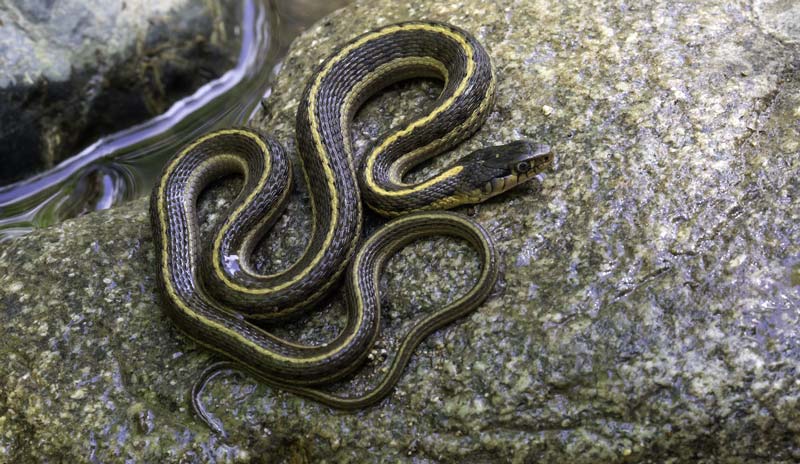

Subspecies in AZ
Wandering Gartersnake
Thamnophis elegans vagrans
Arizona Wandering Gartersnake
Thamnophis elegans arizonae
Mexican Gartersnake
Thamnophis eques
- Harmless
- Rarely encountered
- No action necessary
- Snake fencing not effective
The Mexican Gartersnake is a federally endangered species found that remains in only a handful of Arizona waterways. Semi-aquatic and rarely seen away from association with water, this species looks similar to other gartersnakes in the area. It is typically grey, brown, or greenish with a cream stripe down the back, with white stripes on each side. It lacks the black hood of the black-headed gartersnake. Very similar to the Western Terrestrial Gartersnake, but with a white bar extending halfway up the head, just behind the eye. If one is seen, leave it alone and consider submitting a photograph and location to AZGFD.


Narrow-Headed Gartersnake
Thamnophis rufipunctatus
- Harmless
- Rarely encountered
- No action necessary
- Snake fencing not effective
The Narrow-headed Gartersnake is an endangered species found in a few waterways in central Arizona. They are most often encountered by swimmers visiting Sedona. They are brown or green, typically with a checkerboard arrangement of darker blotches along the entire body, but can also be a solid color. Their head is broad behind large, round eyes, giving the appearance of a watersnake. They are nearly entirely aquatic, rarely seen away from the rocky streams where they swim. If one is found, leave it alone.


Smith's Black-Headed Snake
Tantilla hobartsmithi
- Harmless
- Rarely encountered
- No action necessary
- Snake fencing not effective
These tiny, harmless snakes are most easily identified by their black head, as the name implies. They're often mistaken for young Groundsnakes, which also often appear with a black head, but can be differentiated by the presence of a red or pink stripe on the belly. Adults in Arizona rarely get more than about 10" long. They never bite, and can be ignored if seen in the yard. Repeat sightings of this species could be an indication that the home has termites, however!
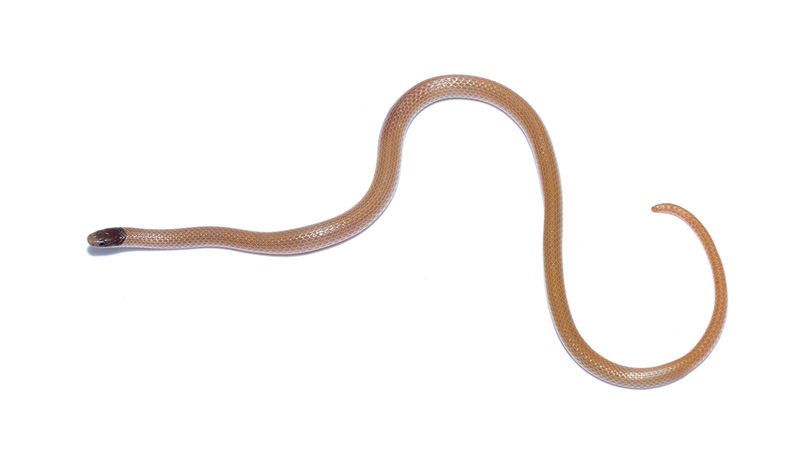

Plains Black-Headed Snake
Tantilla nigriceps
- Harmless
- Rarely encountered
- No action necessary
- Snake fencing not effective
The Plains Black-headed Snake is very small, typically less than a foot long and slender. It is tan or greyish in color with a black head and white cheeks. It can be differentiated from similar black-headed snakes by the lack of a white band on the neck area, and the deep "v" smudge extending backward from the head. This is different than the clean cut-off of the similar-looking Smith's Black-headed Snake. These tiny snakes are harmless and can be ignored if found.

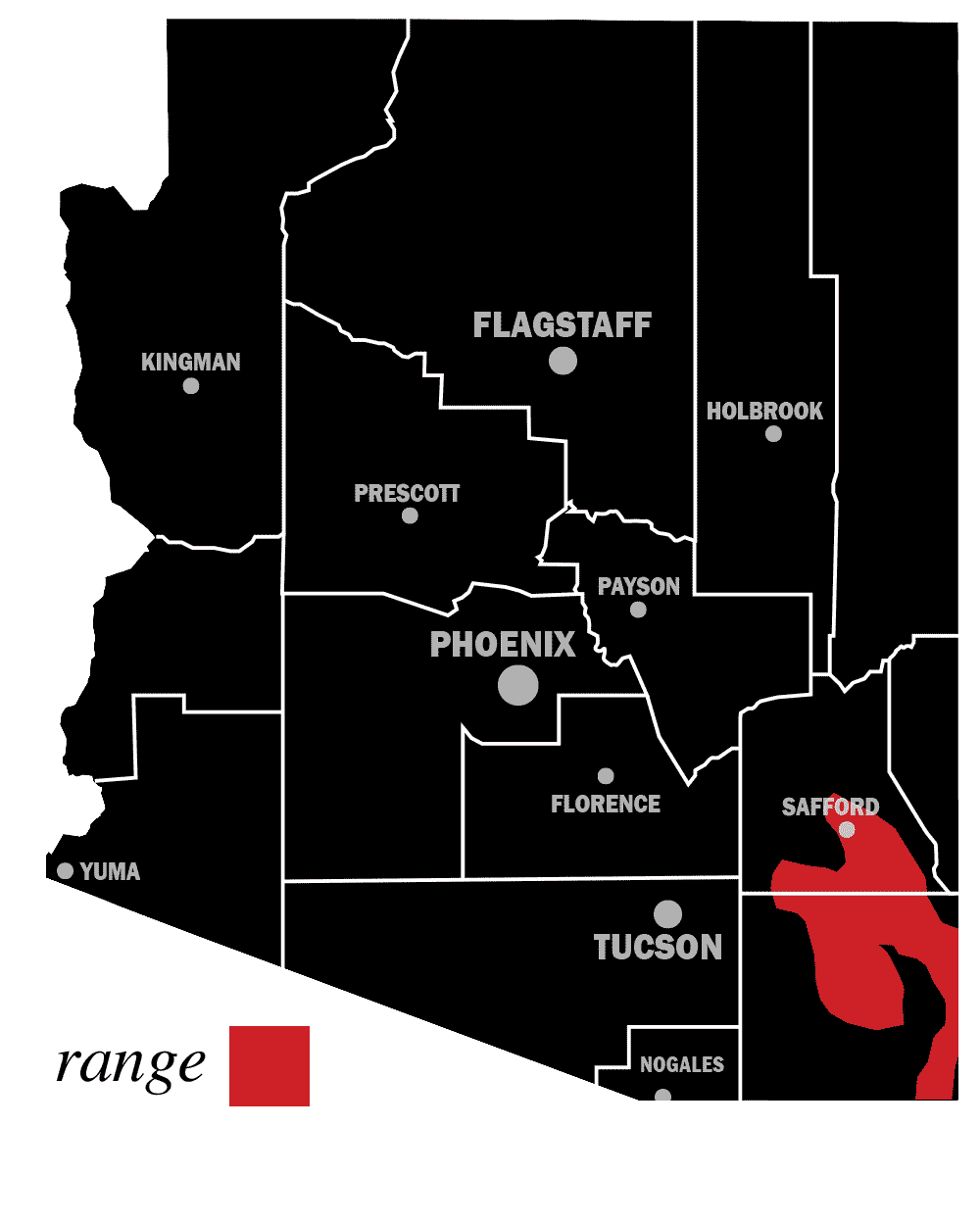
Chihuahuan Black-Headed Snake
Tantilla wilcoxi
- Harmless
- Rarely encountered
- No action necessary
- Snake fencing not effective
The Chihuahuan Black-headed Snake is a tiny, harmless snake found in only a few areas in extreme south-central Arizona. It is sometimes seen crossing roadways after a light rain, under cover or rocks, or crawling in the daytime along stream bottoms. It is typically tan or grey with a black head, separated by a white band that is more than two scales wide. Its belly is orange or pink. Like the other members of the black-headed snake genus, it is entirely harmless and can be ignored if found.
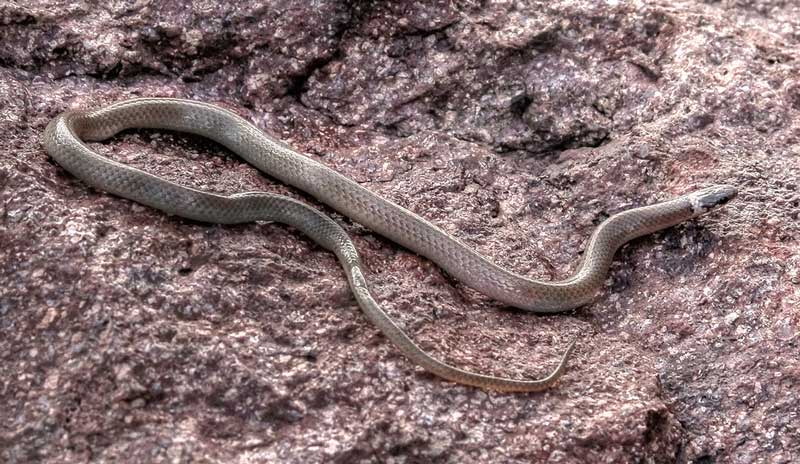

Yaque Black-Headed Snake
Tantilla yaquia
- Harmless
- Rarely encountered
- No action necessary
- Snake fencing not effective
A tiny snake with a black head, similar to other black-headed snakes. Its range is restricted to several mountain ranges in southeastern Arizona, where it is occasionally seen crossing roadways at night, or under flipped rocks. It can be differentiated from other blackheaded snakes by the location of the white band behind the head. On this snake, this band is entirely behind the head and a single scale row in width, starting at the edge of the mouth. This is unlike the Chihuahuan Black-headed Snake, which has a white band more than two scales wide placed more forward on the head. This species may also have a white or grey scale on the nose.
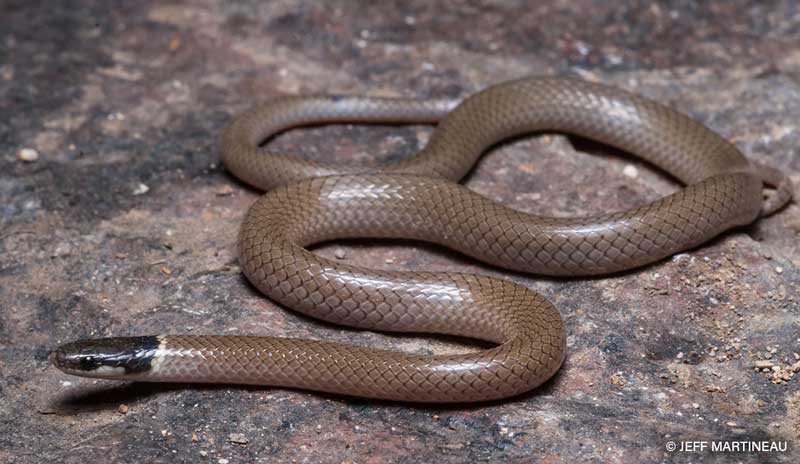

Western Threadsnake
Rena humilis
- Harmless
- Rarely encountered
- No action necessary
- Snake fencing not effective
With a writhing, glossy appearance and tendency to be discovered while digging in loose soil, threadsnakes can be easily mistaken for a worm. A close look at the head, however reveals two dark spots – the vestigial remnants of eyes. They may be pink or brown, and give off a foul smell when handled. They are completely harmless, and feed on termite larvae. They look very similar in apperance to the New Mexico Threadsnake, but can be differentiated by the presence of a single scale between its eye spots, rather than a 3 individual scales.


New Mexico Threadsnake
Rena dissectus
- Harmless
- Rarely encountered
- No action necessary
- Snake fencing not effective
With a writhing, glossy appearance and tendency to be discovered while digging in loose soil, threadsnakes can be easily mistaken for a worm. A close look at the head, however reveals two dark spots – the vestigial remnants of eyes. They may be pink or brown, and give off a foul smell when handled. They are completely harmless, and feed on termite larvae. They look very similar in apperance to the Western Threadsnake, but can be differentiated by the presence of 3 scales between its eye spots, rather than a single scale.


Brahminy Blind Snake
Indotyphlops braminus
- Harmless
- Rarely encountered
- No action necessary
- Snake fencing not effective
This tiny, worm-like snake is often found inside homes and near gardens. Alternatively named the "flower pot snake", for good reason – it is transported around the world from its original Indonesian home in soil and the roots of garden plants. They are tiny (like a stir straw), and usually shiny or "wet" in appearance, though they are not slimy, and the color of dark coffee.Similar to our native threadsnakes, they are completely harmless and can be ignored, or put outside if found indoors.


Chihuanuan Hook-Nosed Snake
Gyalopion canum
- Harmless
- Rarely encountered
- No action necessary
- Snake fencing not effective
The Chihuahuan Hook-nosed Snake is a small, usually strongly patterned brown or tan snake seen infrequently in the grassland habitat of the southeastern corner of Arizona. They have a robust build, being relatively thick in relation to length. The brown base color is crossed with a series of darker, jagged, or speckled bands. The head is round and relatively short, with a slightly upturned nose. These snakes may be mistaken for the superficially similar Mexican Hog-nosed Snakes that also occur in much of their range. They are harmless and do not pose a danger to people or pets.


Thornscrub Hook-Nosed Snake
Gyalopion quadrandulare
- Harmless
- Rarely encountered
- No action necessary
- Snake fencing not effective
The Thornscrub Hooknosed Snake is a small, seldom-seen snake restricted to a handful of small areas in southeastern Arizona. The nose scale is turned slightly upward, as the name implies. Its pattern is a stark black bands alternating with white on the back, and red or orange on the sides. The face has a black "mask", covering both eyes, with a white nose. This is an entirely harmless snake, and can be ignored when found. If one is seen, consider taking a photograph and reporting its location to id@rattlesnakesolutions.com


Mexican Hog-Nosed Snake
Heterodon kennerlyi
- Mildly Venomous
- Rarely encountered
- No action necessary
- Snake fencing not effective
The Mexican Hognosed Snake, known for its characteristic upturned 'hog nose,' is a medium-sized snake that can be found in the grasslands of southeastern Arizona. Typically about a foot long as an adult, it displays a base color of pale grey or tan with darker blotches and a lighter belly. They are active in the daytime and may be seen alongside pools of water in sandy soil as they hunt for amphibians. It is famous for its defensive display; a dramatic feigning death act, where the snake writhes and flops upside down and emits a foul odor to avoid predation. It is mildly venomous but not likely to bite and not generally considered harmful to humans.


Brown Vinesnake
Oxybelis aeneus
- Mildly Venomous
- Rarely encountered
- No action necessary
- Snake fencing not effective
Species description coming soon

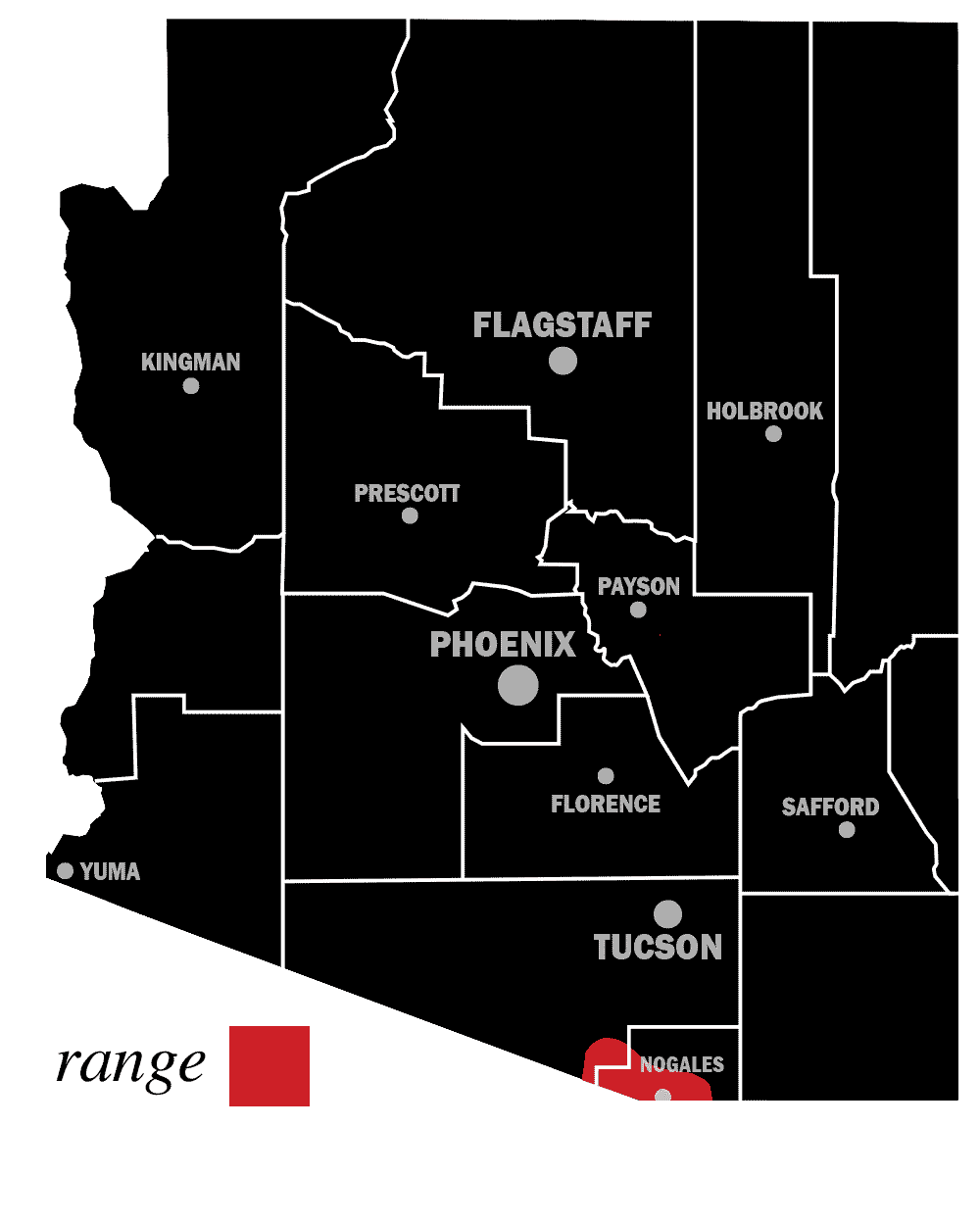
Green Ratsnake
Senticolis triaspis
- Harmless
- Rarely encountered
- No action necessary
- Snake fencing not effective
The Green Ratsnake is found within Arizona in the southeastern portion of the state in a handful of mountain ranges known as the "sky islands." It is a relatively large and slender snake, often up to 4 feet long. It may have a strong pattern as a juvenile, which fades into a solid, olive, or pine green as it matures. These snakes are rarely seen and are a highly prized sight for snake enthusiasts.


Banded Watersnake (invasive)
Nerodia fasciata
- Harmless
- Rarely encountered
- No action necessary
- Snake fencing not effective
The Banded Watersnake is a semi-aquatic snake native to the Southeastern United States, has become invasive in Arizona, in the area around Yuma's waterways. It's a medium to large non-venomous snake, typically 24-42 inches long, with dark bands along its heavy body and a light-colored belly. Its presence in Arizona threatens local ecosystems as it competes with native species for resources. Sightings outside of known infested areas should be reported immediately to info@rattlesnakesolutions.com
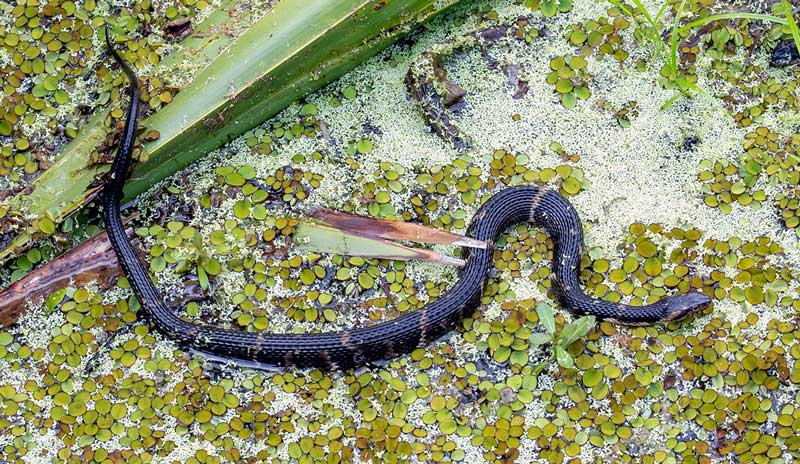

Ball Python
Python regius
- Harmless
- Rarely encountered
- Contact a rescue group
- Snake fencing not necessary
These popular pets are, unfortunately, sometimes found in metro areas of Arizona. Most often found near apartment/condo complexes, these snakes often escape or are released intentionally by pet owners who lose interest. They are not venomous, but can give a painful bite if they are stressed. If you find one, please contact a reptile rescue organization or notify neighbors of the sighting in the event it's just an escaped pet.

